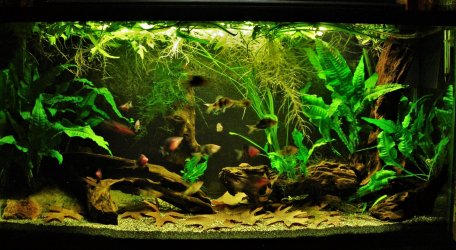Okay so if I were to rehome the barbs and build my stock around 3 gouramis, what options would I have? I’d like to have cories and platy as well. Maybe the rainbow shark. I’m not interested in snails or shrimp. I’d like something colorful and not too small
I would re-home the shark, and increase the cories so they will be better.
Gourami...I assume this 40g is 3 feet in length? If so, the Pearl Gourami (
Trichopodus lerii) is probably the best gourami, in a group of five or six (two males, 3 or 4 females). Floating plants are mandatory with gourami, so that means you can have smaller shoaling fish without any risk. Not that the Pearls would hunt them anyway, but the more temptation is absent the better. Some of the rasboras are ideal with gourami.
Trigonostigma hengeli is my favourite of the three similar "harlequin" pattern rasbora, but there is also the
T. espei and then the very slightly larger common Harlequin,
T. heteromorpha; whichever (do not mix them) in a group of 9-12 if either of the first two, or 7-9 if the latter.
Water parameters are not mentioned yet in this thread, and that could change my suggestions if too hard. Platy must have moderately hard water, a GH of 10 dGH (180 ppm) or higher. Gourami are soft water fish, some very soft water, though the commercially raised fish are less fussy, depending upon the parameters.
Avoid the Blue Gourami and any of the varieties (Gold, Cosby, Three-Spot, Opaline, Marble). This species,
Trichopodus trichopterus, is the most aggressive of all the small/medium species. Like all gourami, males are territorial (just like cichlids), but this aggression varies among species, and sometimes within individuals of a species. Males have been known to kill others of the species and even every other fish in the tank, and one member even had a female who started down this road.
Honey Gourami are peaceful (for gourami anyway). Avoid the Dwarf Gourami unless you can obtain them directly from the breeder; the non-curable iridovirus is still a risk with commercial DG's.
Going on with gourami, and assuming softish water (these will be much more sensitive, probably wild caught), the Chocolate, pygmy sparkling, Eye-Spot, and several others much less often seen. Some of these will work even with the beautiful dwarf rasboras in the genus
Boraras, like
B. brigittae. I had these in with a group of Chocolate Gourami a few years ago, and I previous to that had a group of Chocolates in with a group of pygmy sparkling, and some of the
T. hengeli rasbora I mentioned earlier. Both gouramis spawned several times. The Chocolates are highly sensitive to skin problems and bacterial issues though, and they need much warmer water.



